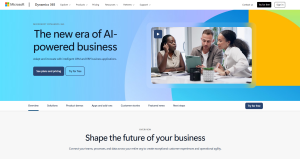Supply chain software isn’t just changing business operations – it’s reshaping how companies survive in 2025. When a manufacturing company in Detroit cut its operating costs by 32% last quarter, they didn’t hire expensive consultants. They used smart supply chain visibility tools, allowing them to track raw materials and shipments in real time.
But here’s what matters: You’re probably losing money right now if you haven’t updated your order management systems. SAP SCM and Blue Yonder are leaders in the market, helping businesses mitigate risk and stay ahead of consumer expectations.
Supply Chain Profitability: Accenture research reveals that companies with advanced supply chains enjoy a 23% higher profitability compared to their competitors.
Think about this for a second.
How much time does your team spend on manual order processing? How often do you deal with stock shortages or excess inventory? How many hours go into tracking shipments and managing suppliers?
The answers to these questions directly impact your bottom line. Supply chain management software changes these answers dramatically. It turns hours of work into minutes, converts guesswork into informed decisions, and transforms complex logistics into smooth operations, improving your customer experience.
This guide shows exactly how supply chain software will cut costs and save time in 2025. We’ll look at real AI solutions that predict risk-resilient disruptions before they happen, helping you stay agile in a world full of uncertainty. We’ll examine how IoT sensors are making inventory management precise and how cloud-based technologies allow companies to scale and adapt. And we’ll see how blockchain technology is ending the nightmare of lost shipments, ensuring deliveries reach their final destination without issues.
Small changes in end supply chain efficiency create big impacts on profit margins. The difference between staying competitive and falling behind often comes down to how well you manage your cloud-native systems. Allowing companies to quickly respond to changes in demand is a competitive advantage that can’t be overlooked.
Let’s look at the specific features and strategies that will help you deliver better results in 2025, ensuring your service meets or exceeds customer expectations.

Lower your delivery costs by 23%
How we reduce costs:
- No delivery vehicle expenses
- Optimized local routes
- Pay-per-delivery model
- Average 23% delivery cost reduction
Maximize Efficiency with Features of Supply Chain Management Software
-
Get instant updates and insights with real-time tools.
-
Speed up tasks and reduce human mistakes.
-
Control your stock better, saving both time and resources.
Real-time Monitoring and Analytics
Supply chain management software offers real-time monitoring capabilities that allow businesses to track orders, deliveries, and more as they happen. This immediate access to information is critical for spotting and resolving issues early, a process that becomes even smoother with application modernization. For example, if there’s an unexpected delay in a shipment, managers can quickly find alternative solutions, minimizing interruptions. Moreover, real-time data allows for proactive decision-making, as businesses can predict trends and respond promptly. These tools not only enhance operational efficiency but also contribute to customer satisfaction by ensuring that deliveries are on time and accurate.
Proactive Management Gap: Only 22% of companies have a proactive supply chain network, which can address shifts in supply or demand before they become critical issues.
Analytics provided by these software tools enable businesses to capitalize on data-driven insights. Predictive analytics can forecast potential disruptions or inefficiencies, guiding managers to take preventative measures. Understanding past performance helps in planning future strategies with greater confidence. A deeper resource for those interested in the subject is “Data Science for Business” by Foster Provost and Tom Fawcett. This book delves into the implications of using data for strategic business decisions. Still, the downside is the investment required in skilled staff who can interpret these analytics effectively. Pros must balance these needs against the potential gains from efficiency improvements.
Automated Order Processing
Automated order processing transforms how businesses handle orders by reducing manual input and therefore, the potential for errors. Instead of relying on employees to process orders, software efficiently and accurately manages the task. This automation speeds up the ordering process, ensuring quicker turnaround times and reduced costs. Labor costs go down as fewer people are needed for data entry tasks, allowing those resources to focus on more strategic activities.
With fewer human touches required, there’s less room for mistakes, improving accuracy in orders and reducing returns. A further read into the broader impacts of automation can be found in Martin Ford’s “Rise of the Robots,” exploring how automation shapes various industries. Advocacy for automation often cites efficiency gains and cost reductions. However, critics point out potential job losses as tasks become more computerized. Balancing technology and workforce implications is a delicate task for managers implementing these systems.
Inventory Management
Effective inventory management through supply chain software helps maintain optimal stock levels while reducing waste and overstock situations. Simplified inventory management means businesses can avoid tying up capital in excess stock, which can lead to improved cash flow. At the same time, software solutions minimize stockouts, ensuring products are available when customers demand them, enhancing customer satisfaction and loyalty.
Inventory Tracking Gap: Approximately 43% of small businesses do not track their inventory, highlighting a significant gap in supply chain management practices.
The benefits of a streamlined inventory system extend to waste reduction, as companies can avoid holding onto products that might become obsolete. Reading “The Lean Startup” by Eric Ries could give insights into lean methods applied in inventory management. While these benefits are clear, challenges include the accurate integration of existing systems, as well as training staff to use new software effectively. Companies must weigh these hurdles against the potential for long-term benefits like reduced operational waste and improved customer satisfaction.
Slash Costs with Supply Chain Optimization Benefits
Predict demand accurately to reduce excess inventory and holding costs.
Strengthen supplier ties for better pricing and terms.
Optimize transport logistics to cut fuel costs and a number of trips.
Improved Demand Forecasting
Software-driven demand forecasting helps match supply with actual market needs. This aligns inventory with demand patterns, reducing two main cost drivers: excess inventory and holding costs. As a result, businesses keep only what’s needed on the shelf, minimizing waste and freeing up capital.
Statistical methods like exponential smoothing and machine learning enhance forecasting accuracy. These determine what stock to carry and when to reorder. A key text on this subject is “Demand Forecasting and Inventory Control” by Nick T. Thomopoulos, which dives into statistical methodologies. Implementing these models can be complex, requiring skilled analysts and reliable data. The payoff is significant—fewer stockouts and reduced carrying costs. Case studies, such as those published by the Journal of Business Logistics, often illustrate successful forecasting in diverse industries.
For those looking to deepen their understanding, forums, and webinars hosted by institutions such as APICS or the Council of Supply Chain Management Professionals offer further insights into demand forecasting techniques.
Supplier Relationship Management
Building solid relationships with suppliers can lead to cost savings through better pricing and enhanced contract terms. Software tools facilitate communication, enabling smooth negotiations and avoiding misunderstandings. Strong supplier ties mean quicker responses to issues like material shortages or delays.
A well-cited resource, “Supplier Relationship Management: Unlocking the Hidden Value in Your Supply Base” by Jonathan O’Brien, highlights the strategic importance of supplier management. The book outlines methods to classify suppliers, the nuances of negotiation, and the risks associated with this strategy. Such strategies help businesses secure more favorable terms, such as bulk discounts or extended payment terms, lowering overall procurement costs.
On the flip side, an over-reliance on a few suppliers might pose risks if one fails to meet obligations. Studies from the MIT Sloan School of Management stress diversifying the supplier base to mitigate this risk. Attending workshops and training sessions can further bolster supplier management skills.
Transportation Management
Effective transport management cuts costs by optimizing route planning. Software solutions calculate efficient paths to lower fuel use and minimize trip numbers. Load optimization ensures each trip carries the maximum permissible weight, reducing transportation expenses.
Potential Financial Losses: Supply chain disruptions can lead to financial losses of up to 62% for affected companies.
“Transportation Management with SAP TM” by Jayant Daithankar offers guidelines for integrating transport management systems into existing supply chains. This and other resources delve into route planning algorithms and real-life applications. Conversations in logistic forums suggest that users see a significant drop in operational expenditures as software adapts to variables like traffic patterns or weather conditions.
However, implementing such tools requires investment in IT infrastructure and training, a hurdle noted in research by Gartner. Businesses should carefully consider potential ROI, informed by case studies showing cost savings post-implementation. Various online courses can provide insights into transportation innovations and potential cost reductions.
This detailed examination of supply chain optimization not only answers the question of how it reduces costs but also introduces deeper aspects of logistics and resource management. By engaging with advanced studies and tools, businesses can drastically improve their bottom line.
Time-Saving Technologies in Logistics for Supply Chain Planning in 2025
Technologies speed up logistics for fast problem-solving.
Real-time data helps make better decisions.
Enhanced transparency in supply chains prevents shipment loss.
Technology Underperformance: 67% of businesses report underperforming technology solutions, indicating a need for improved supply chain tech integration.
AI-Powered Solutions
Artificial Intelligence (AI) is changing how logistics work. Quick responses to supply chain disruptions are crucial in saving time. AI algorithms can quickly identify problems and suggest real-time solutions. This capability is not confined to basic issue identification but includes predictive functionalities. Consider AI as a tool that can predict disruptions by analyzing patterns. For instance, AI tools can analyze weather data to predict potential disruptions, altering routes to avoid delays.
AI doesn’t stop at predicting and fixing problems. It provides valuable insights that enhance decision-making. For example, machine learning algorithms can process historical and current data to forecast demand with high accuracy. This can prevent overstocking or stockouts, which are common issues.
Books like “AI Superpowers” by Kai-Fu Lee discuss AI’s broader implications, offering a context for understanding its transformative role in logistics. Critics sometimes highlight AI’s dependency on big data, suggesting it’s only as effective as the quality of the data it processes. Engagement with these criticisms can provide a more nuanced understanding of AI’s strengths and limitations.
Blockchain Integration
Blockchain technology is gaining traction for improving transparency and traceability in logistics. Companies like IBM and Maersk have already implemented it to track shipments globally. Blockchain ensures that all transactions are recorded in a transparent, immutable ledger. This means that each step of the supply chain is visible, from the initial supplier to the end customer.
This transparency drastically reduces the risk of lost shipments, a nightmare for logistic managers. A Harvard Business Review article discusses the successful reduction of fraud and loss in trade finance using blockchain. The distributed ledger technology also enables several parties to update and view records in real time, creating a unified source of truth for transactions and shipments.
On the downside, some critics argue that blockchain integration is cumbersome and costly. Despite the initial costs, the long-term benefits often outweigh the investment. For those wanting to explore this further, “Blockchain Basics” by Daniel Drescher is an excellent starting point for understanding its complexities.
Internet of Things (IoT)
The Internet of Things (IoT) provides tangible ways to optimize logistic operations by equipping assets with smart sensors. These sensors gather and transmit data from vehicles, warehouses, and shipping containers. By monitoring conditions such as temperature and humidity in real-time, logistics managers can ensure that sensitive products remain within specified parameters, minimizing loss.
The IoT’s capability for real-time monitoring leads to enhancements in efficiency and asset utilization. For instance, connected devices can relay data on GPS locations, fuel usage, and driver behavior, allowing for more efficient route planning.
IoT's Impact on Productivity: A study conducted by McKinsey found that companies implementing IoT technologies can see a 10-20% increase in productivity, with some instances reporting increases as high as 30% due to enhanced data collection and analysis capabilities
IoT implementation does pose some concerns like data security and privacy issues. However, the benefits often outweigh the drawbacks in terms of saved time, enhanced monitoring, and improved stakeholder transparency. To delve deeper into IoT and its applications, Kevin Ashton’s work “How to Fly a Horse: The Secret History of Creation, Invention, and Discovery” covers its inception and gradual integration into everyday life.
Cost Reduction Strategies in Supply Chain Operations for the Coming Year
Save costs with lean manufacturing.
Enhance supplier deals via strategic sourcing.
Reduce risks with proactive management.
Cost Reduction Impact on Profits: Reducing supply chain costs from an average of 9% to 4% can potentially double profits, demonstrating the financial benefits of optimization efforts.
Optimize Production Processes
Lean production is a proven way to lower costs. It focuses on removing waste and using resources wisely. By cutting out redundant steps, companies can increase efficiency and boost output.
Identify Waste: Inspect all aspects of production. Look for areas where resources like time, labor, or materials are not used effectively.
Streamline Workflows: Remove unnecessary tasks. Simplifying processes can significantly cut down on costs. This might involve reducing the number of steps in a manufacturing process.
Continuous Improvement: Adopt a mindset of constant refinement. Implement changes regularly based on feedback and new insights. As Taiichi Ohno said, “Reduce the value stream timeline by removing non-value-added wastes.”
Train Employees: Teach staff about lean techniques. They should understand how to identify inefficiencies and suggest improvements.
Use Technology: Leverage advanced tools for better insights into waste. Analytics and AI can provide real-time data to support decisions.
Strategic Sourcing
Picking the right suppliers can drastically affect cost savings. Strategic sourcing takes more than cost into account; it considers value, quality, and reliability.
Supplier Evaluation: Assess potential suppliers for value. Factor in cost, quality, delivery times, and dependability.
Long-term Partnerships: Build ongoing relationships with vendors. Long-term deals often lead to better terms and increased trust.
Negotiating Terms: Being prepared for negotiations can lead to better pricing. Learn about supplier constraints and align offers accordingly.
Diversifying Supplies: Avoid relying on a single supplier. Diverse sources prevent disruptions and foster competition.
Sustainability: Choose suppliers who prioritize sustainability. Sustainable practices can be more cost-effective over time.
Notice that “the result of long-term relationships is better quality, and lower costs.” This is important when considering strategic sourcing.

Effective Risk Management
Identifying and managing risks can prevent unexpected costs. Risks can affect every part of a supply chain, so it pays to be prepared.
Risk Identification
Risk Assessment: Begin by listing possible risks. These could include supplier failures, transportation issues, or environmental impacts.
Data Analysis: Use historical data to understand patterns. Advanced analytics and AI models predict risks, enabling better planning.
Contingency Planning
Draft Plans: Develop detailed contingency plans for different scenarios. Prioritize based on the likelihood and impact of risks.
Allocate Resources: Ensure resources are available to enact plans. This might involve directing funds, staff, or technology to manage risks efficiently.
Regular Testing: Run regular tests of contingency plans to identify weaknesses. Adjust strategies based on outcomes.

The effective management of supply chains involves both proactive and reactive strategies, ensuring that firms are ready to handle challenges while keeping costs low.
Conclusion
Supply chain management software has changed the way businesses handle their operations in 2025. The mix of AI, IoT sensors, and blockchain creates a system that spots issues early and fixes them fast. This means fewer errors, less waste, and more savings, leading to a resilient supply chain that’s ready for any challenge.
The impact on costs is clear. Better demand predictions mean you won’t have extra stock sitting around in your supply network. Smart route planning cuts fuel costs. Real-time tracking stops lost shipments. When you add up these savings over a year, the numbers are hard to ignore for supply chain professionals looking to improve business success.
Time savings are just as big. Tasks that took hours now happen in minutes. Automated orders remove human error, supporting a sustainable supply chain. AI helps make quick, smart choices during problems, driving better product lifecycle management. Your team can focus on growth instead of fixing mistakes, enhancing the value across today’s supply chain.
But the real power comes from using all these tools together. When your inventory system talks to your shipping software, which connects to your supplier portal and aligns with your trading partners—that’s when the magic happens. Your integrated software creates a smooth, cost-effective digital supply chain that’s prepared for whatever comes next.
The tools are here. The technology works. The question is: How will you use these systems to transform your supply chain management in 2025? Implementing effective stock management strategies can significantly enhance your business operations, ensuring that you maintain optimal inventory levels while minimizing costs and maximizing service levels. By focusing on accurate demand forecasting, consistent inventory audits, and leveraging technology, businesses can thrive in an ever-competitive landscape.


























